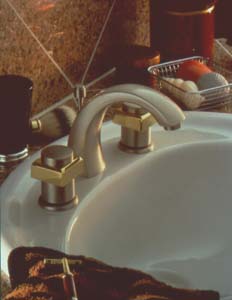Brass Kitchen Faucet
DEAR TIM: Both my plumber and husband have let me down. I am now forced to install a new polished brass kitchen faucet that I am about to purchase. The water supply lines and chrome shut off valves are already in place in the sink cabinet. How do I complete this job with no leaks? How can I protect the brass faucet from tarnishing? My water supply contains chlorine. What can I do to remove the smell and taste from the water? Abby D., Florence, AL
DEAR ABBY: Forget about those two losers. You are going to complete this faucet installation in less than two hours with a few simple tools and accessories, some plumbers putty, and several wrenches. If you pay attention to a few details, you will complete this simple job with absolutely no leaks. Before you proceed, be sure your local plumbing code permits you to install this simple fixture. Some states have stringent codes that do not allow unlicensed people to perform this work.

Let's talk about polished brass. You can now purchase new kitchen or bath brass faucets that will never tarnish. The faucets are put into a vacuum chamber and bombarded with molecules of special metals. The result is a thin tarnish free alloy at the surface of the faucet. The finish is very durable and can't be scratched by steel wool.
When you go to select your faucet, look for the ones that have a split finish. These have a mixture of chrome and brass within the faucet. These work well to pull together the chrome trim one often has on appliances and the solid brass cabinet handles found in many kitchens. Check out the new faucet spouts. Many have a higher rise so large pots can be cleaned more easily. Some spouts extend up to 9 inches away from the faucet base.
The easiest way to attach a kitchen faucet to a sink is to do it before the sink is installed in the countertop. If the sink is already installed in the top, you will need to buy an inexpensive basin wrench. This wrench has a swivel head that allows you to tighten the faucet bolts in the narrow area between the back of the sink cabinet and the kitchen sink basin. A regular wrench simply will not fit in this area. Read the instructions and use plumber's putty under the faucet or faucet gasket if called for. The putty fills any gaps and prevents water from flowing under the faucet into the sink cabinet below.
Once the faucet is secure to the sink, you simply connect the water supply lines to the faucet. This is accomplished by using chrome or plastic supply tubes. These supply tubes have different ends depending upon the configuration of the faucet you buy. Purchase the correct tubes and the right length at the same time you purchase the faucet. It is always a good idea to get longer tubes as you can cut them to length back at the jobsite.
The supply tubes are flexible. Hold them into position and bend them as necessary between the faucet and the valve. Always cut them a little long as you can cut off more if necessary. The supply tubes need to connect squarely with the faucet and the chrome shut off valves. If a supply tube connects with the faucet or shut off valve at an angle, you will undoubtedly have a leak.
Tighten the nuts at each end of the supply tube until you feel moderate resistance. Do not over-tighten these nuts. Remove the aerator from the faucet before you turn on the water. This prevents the fine screening from getting clogged by globs of flux, pipe shavings, and sediment. Open the shut off valves slowly one at a time and check for leaks. If a droplet of water forms at one end of the supply tube(s) tighten the nut until the leak stops. Turn the faucet handle to draw water. Once the water runs clear and there are no leaks, reinstall the aerator.
You can purchase a smart looking kitchen faucet that has a hidden chlorine filter in the spout. You simply turn a small knob at the end of the faucet to activate the filtered flow. You only use this filter when you need drinking or cooking water. Turn the knob back to rinse dishes or clean with chlorinated water. If you don't want this filter faucet you can also remove chlorine from water by boiling it for just one minute. If you choose not to boil the water, simply draw the water from the sink and let it sit out overnight. The chlorine will dissipate on its own.
Related Articles: Tarnish Free Brass Faucets, Brass Faucet Manufacturers